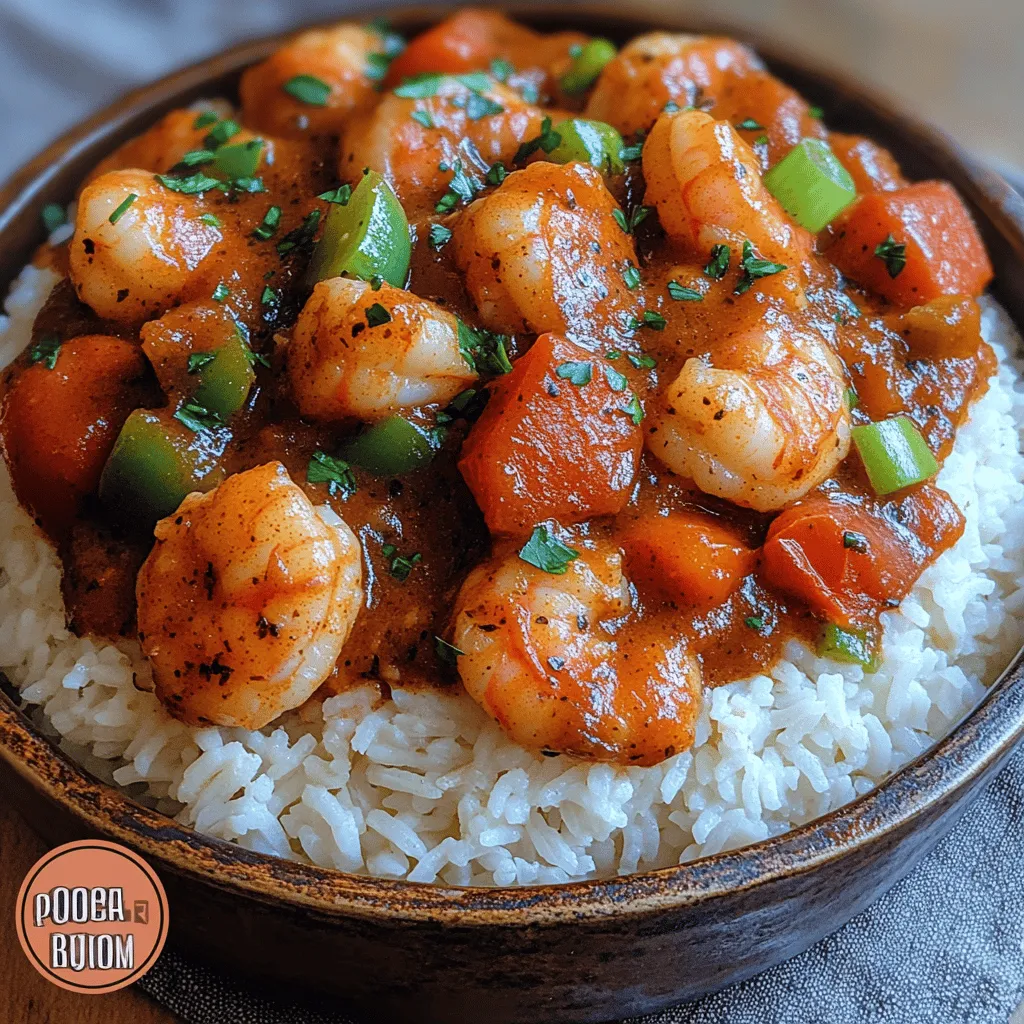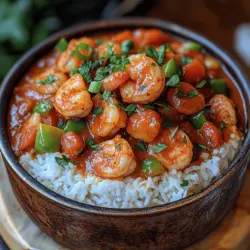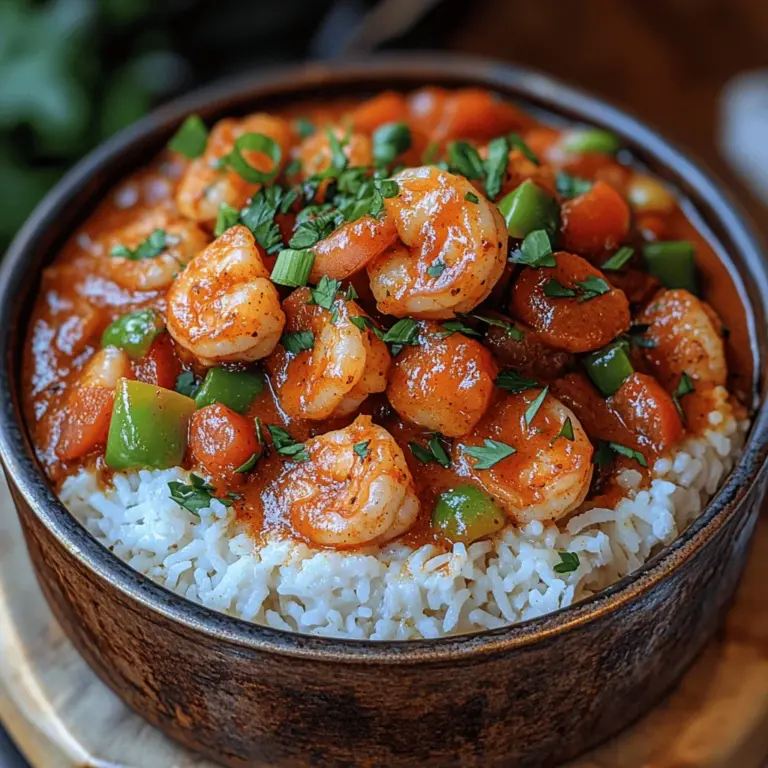Introduction
When it comes to the rich tapestry of Louisiana cuisine, few dishes are as emblematic as Shrimp Étouffée. This classic dish is a celebration of flavor, combining succulent shrimp with a savory roux and an array of aromatic vegetables. The term “étouffée” translates to “smothered” in French, which perfectly describes the way this dish envelops its key ingredients in a savory sauce. Often served over rice, this dish not only satisfies the palate but also warms the soul.
As we delve into this Smoky Cajun Shrimp Étouffée recipe, we’ll explore the importance of seasonal ingredients and how they elevate this dish. In addition, we’ll touch on the cultural significance of Étouffée within families and communities, particularly in the vibrant culinary landscape of Louisiana.
Seasonal ingredients play a crucial role in crafting an authentic Étouffée. Using fresh, locally sourced produce enhances the dish’s flavor profile and contributes to its nutritional value. In Louisiana, the warm climate allows for a variety of vegetables to flourish year-round. By incorporating fresh produce, you not only support local farmers but also enjoy the best flavors that each season has to offer.
Beyond the ingredients, Shrimp Étouffée often embodies family traditions, passed down through generations. Many families have their unique spin on the recipe, sometimes incorporating heirloom spices or family-grown vegetables. Cooking this dish can evoke memories of shared meals and cherished moments, making it a staple for gatherings and celebrations.
Understanding the Key Ingredients
To create a truly memorable Smoky Cajun Shrimp Étouffée, it is essential to understand the key ingredients that bring this dish to life.
Overview of Primary Ingredients
The foundation of this dish is built upon a select few core ingredients: shrimp, a dark roux, the “holy trinity” of Cajun cooking (bell peppers, onions, and celery), and a blend of spices that impart depth and character.
Description of the Main Protein Source
Shrimp is the star of this dish, providing a delicate yet robust flavor that pairs beautifully with the other components. When choosing shrimp, look for fresh, sustainably sourced options. The size of the shrimp can vary, but medium to large shrimp work best, as they hold up well during the cooking process and offer a satisfying bite.
Highlighting Seasonal Vegetables
In addition to shrimp, the vegetables used in Étouffée enhance both flavor and texture. The “holy trinity” consists of chopped onions, green bell peppers, and celery, which form the aromatic base of the dish. These vegetables are often available year-round, but using them at their peak ripeness will yield the most vibrant and flavorful results.
You might also consider adding seasonal vegetables like diced tomatoes or corn, depending on what’s available in your local market. These additions can provide a fresh twist and bring out the essence of the dish.
Importance of Spices and Herbs
The true magic of Cajun cooking lies in its spices. A blend of paprika, cayenne pepper, and thyme gives this Smoky Cajun Shrimp Étouffée its signature kick and warmth. The smokiness often comes from the use of smoked paprika, which adds a complex flavor without overpowering the dish.
Fresh herbs like parsley and green onions can be used as garnishes, offering a burst of color and freshness. The balance of spices is crucial; they should enhance the dish without overshadowing the natural sweetness of the shrimp.
Nutritional Benefits of the Ingredients
This dish not only pleases the taste buds but also offers nutritional benefits. Shrimp is an excellent source of lean protein and is low in calories, making it a healthy option for various diets. The vegetables contribute fiber, vitamins, and minerals, while the spices may offer anti-inflammatory properties. Overall, this dish can be a wholesome addition to your culinary repertoire.
Suggestions for Ingredient Substitutions
Flexibility is one of the great advantages of cooking. If shrimp isn’t available or if you’re looking for a vegetarian alternative, consider using mushrooms or tofu to create a similar texture. For those who prefer a different protein, chicken or crab can be excellent substitutes.
If you’re sensitive to heat, you can adjust the spices to suit your taste. Reducing cayenne pepper or opting for milder spices will allow you to enjoy the dish without overwhelming your palate.
Preparation Techniques
Before diving into the cooking process, it’s essential to gather the necessary kitchen tools and equipment. Proper preparation sets the stage for a successful cooking experience.
Essential Kitchen Tools and Equipment
1. Large Skillet or Dutch Oven: Ideal for making the roux and sautéing the vegetables.
2. Wooden Spoon: For stirring the roux and preventing it from sticking.
3. Chopping Board and Knife: Essential for preparing your vegetables and shrimp.
4. Measuring Cups and Spoons: For accurate measurements of ingredients and spices.
5. Ladle: Useful for serving the Étouffée over rice.
Step-by-Step Preparation Guide
1. Mise en Place: Before you begin cooking, gather all your ingredients and chop your vegetables. This step, known as mise en place, helps create an organized cooking environment and ensures you have everything on hand when you need it.
2. Washing and Chopping Vegetables: Rinse your vegetables thoroughly under cold water. For the onions, bell peppers, and celery, chop them into small, uniform pieces to ensure even cooking.
3. Marinating or Seasoning the Protein: If you’re using shrimp, it’s a good idea to season it lightly with salt and pepper, or even marinate it briefly with a splash of lemon juice and Worcestershire sauce for added flavor.
4. Preparing the Roux: The roux is a critical component of Étouffée, providing both flavor and thickness. To make the roux, heat equal parts oil and flour in your skillet over medium heat. Stir continuously until the mixture turns a deep brown color, reminiscent of chocolate. This process takes time and patience but is essential for developing the dish’s flavor.
Importance of Mise en Place for Efficiency
Mise en place is not just a professional cooking technique; it’s beneficial for home cooks as well. By preparing your ingredients ahead of time, you’ll streamline the cooking process, minimize stress, and ensure that you don’t overlook any crucial steps. This preparation allows you to focus on the cooking techniques and flavors, resulting in a more enjoyable cooking experience.
Cooking Methods
The cooking methods used in this Smoky Cajun Shrimp Étouffée are integral to achieving the perfect balance of flavors and textures.
Overview of Cooking Techniques Used in the Recipe
The primary cooking technique for this dish is sautéing, which allows the vegetables to soften and release their flavors while the roux thickens the sauce. Additionally, simmering the dish after adding the shrimp allows the flavors to meld beautifully.
Explanation of Sautéing, Roasting, or Grilling
Sautéing involves cooking ingredients quickly over medium to high heat while stirring frequently. This technique is essential for developing the flavor base of the Étouffée. You can also consider roasting or grilling your vegetables separately to add a unique depth of flavor, though traditional Étouffée relies on sautéing.
Tips for Achieving Perfect Texture and Flavor
1. Monitor the Roux: Keep a close eye on your roux as it cooks; stirring constantly prevents it from burning. Aim for a deep, caramel color for optimal flavor.
2. Add Ingredients in Stages: When adding the vegetables to the roux, start with the onions, followed by the bell peppers and celery. This staggered approach allows each vegetable to cook properly and enhances the overall flavor.
3. Don’t Rush the Simmer: After adding the shrimp, allow the dish to simmer gently. This step ensures the shrimp cook evenly and absorb the rich flavors of the sauce.
Potential Variations in Cooking Methods Based on Dietary Preferences
For those following a gluten-free diet, consider using a gluten-free flour alternative for the roux. If you prefer a lighter version, you can reduce the amount of oil used or substitute coconut milk for a creamy yet dairy-free sauce.
In the next section, we will provide a comprehensive list of ingredients and detailed step-by-step instructions for making this delightful Smoky Cajun Shrimp Étouffée.

Visual Cues or Tips for Each Stage of the Cooking Process
To ensure that your Smoky Cajun Shrimp Étouffée turns out perfectly, keep an eye on the visual cues throughout the cooking stages. When cooking the roux, it should turn a rich, chocolate brown color, which typically takes about 20 to 30 minutes over medium heat. Stir continuously to prevent burning. Once you add the vegetables, they should become tender and fragrant, releasing their natural sugars. When you add the broth, look for a smooth consistency—any lumps may indicate that the roux wasn’t fully incorporated. Finally, as the shrimp cook, they should turn pink and opaque, signaling they are ready to be served.
Serving Suggestions
Ideal Side Dishes or Accompaniments
Smoky Cajun Shrimp Étouffée is a dish that shines on its own, but pairing it with the right sides can elevate the dining experience. Here are some ideal accompaniments:
– Steamed White Rice: The classic choice, rice absorbs the flavorful sauce beautifully. For a twist, consider using brown rice or jasmine rice for added flavor and texture.
– Crusty French Bread: Perfect for soaking up the rich sauce, a good loaf of French bread can provide a delightful crunch and contrast to the dish.
– Coleslaw: A tangy coleslaw can add freshness and crunch, balancing the dish’s richness.
– Green Salad: A simple salad with mixed greens, tomatoes, and a light vinaigrette can provide a refreshing counterpoint to the spice of the étouffée.
Presentation Tips for an Appealing Plate
Visual appeal can enhance the dining experience, so consider these presentation tips:
– Use a Shallow Bowl: Serve the étouffée in a shallow bowl to show off the vibrant colors of the dish.
– Garnish: Add freshly chopped parsley or green onions on top for a pop of color and freshness.
– Serve with a Lemon Wedge: A wedge of lemon not only adds color but also allows guests to squeeze a bit of acidity over the dish, enhancing the flavors.
– Neat Serving: When plating, ensure that the rice is centered, and the shrimp are arranged nicely over the top, with sauce drizzled around the edges for an elegant look.
Pairing Recommendations for Beverages
The right beverage can complement the flavors of your dish. Here are some excellent pairing options:
– White Wine: A chilled Sauvignon Blanc or a dry Riesling can enhance the flavors of the shrimp and spices.
– Beer: A light lager or a pale ale can balance the heat of the Cajun spices while refreshing the palate.
– Iced Tea: Unsweetened iced tea with a slice of lemon can provide a nice contrast to the richness of the étouffée.
– Sparkling Water: For a non-alcoholic option, sparkling water with a twist of lime can cleanse the palate beautifully.
Exploring Variations of the Recipe
Suggestions for Dietary Modifications
This Smoky Cajun Shrimp Étouffée recipe can be adjusted to suit various dietary needs:
– Vegetarian or Vegan Alternatives: Substitute shrimp with firm tofu or jackfruit, which can absorb the flavor of the sauce well. Use vegetable broth instead of chicken broth to keep it plant-based.
– Gluten-Free Options: Use gluten-free flour for the roux and ensure that the broth and other ingredients are labeled gluten-free to accommodate those with gluten sensitivities.
– Cultural Variations or Regional Twists: Consider incorporating local ingredients or spices that reflect your cultural background, such as adding a hint of coconut milk for a Caribbean twist or incorporating local seafood varieties for a different flavor profile.
How to Incorporate Leftovers Creatively
Leftovers can be transformed into new meals. Here are some creative ideas:
– Shrimp Étouffée Tacos: Use corn tortillas to create tacos, topping them with cabbage slaw and a drizzle of lime crema.
– Cajun Shrimp Pasta: Toss leftover étouffée with cooked pasta for a hearty meal. Add some fresh herbs and a squeeze of lemon for brightness.
– Soup: Add broth to leftover étouffée to create a delicious soup, garnishing with fresh herbs and a dollop of sour cream.
Storing and Reheating
Best Practices for Storing Leftovers
To keep your Smoky Cajun Shrimp Étouffée fresh:
– Refrigeration: Store leftovers in an airtight container in the refrigerator for up to 3 days.
– Freezing: For longer storage, freeze in a heavy-duty freezer bag or container. It can last up to 3 months in the freezer.
Recommendations for Freezing and Defrosting
To ensure the best quality when freezing:
– Cool Completely: Allow the étouffée to cool completely before freezing to prevent ice crystals from forming.
– Defrosting: Thaw in the refrigerator overnight before reheating. For quicker thawing, place the sealed container in cold water.
Tips for Reheating to Maintain Flavor and Texture
When reheating, follow these tips to keep the dish delicious:
– Stovetop Method: Reheat over low heat in a saucepan, adding a splash of broth or water if it appears too thick.
– Microwave Method: If using a microwave, cover the container with a lid or microwave-safe wrap, heating in short bursts and stirring in between to ensure even heating.
Health Benefits of the Recipe
Analysis of the Nutritional Profile of the Dish
Smoky Cajun Shrimp Étouffée can be a nutritious addition to your meal rotation:
– Shrimp: A great source of lean protein, low in calories, and packed with nutrients like selenium and vitamin B12.
– Vegetables: The dish includes a variety of vegetables like bell peppers, onions, and celery, which provide essential vitamins and antioxidants.
– Healthy Fats: Using a moderate amount of oil in the roux can provide healthy fats, especially if you opt for olive or avocado oil.
Benefits of Incorporating This Recipe into a Balanced Diet
Incorporating this recipe can contribute to a balanced diet by:
– Protein Source: Providing a significant source of protein, which is essential for muscle repair and overall health.
– Flavorful Variety: Introducing a complex blend of spices and flavors can help maintain interest in healthy eating.
– Meal Versatility: The dish can be part of a balanced meal when paired with whole grains and leafy greens.
Discussion on Seasonal Eating and Its Advantages
Embracing seasonal ingredients can enhance the flavors of your étouffée and support local agriculture. Seasonal eating can:
– Increase Freshness: Ingredients are often fresher and more flavorful when in season.
– Support Sustainability: Choosing local, in-season produce can reduce carbon footprints and support local economies.
– Enhance Nutrition: Seasonal fruits and vegetables often contain more nutrients than those that have been transported over long distances.
Incorporating the Recipe into Your Meal Planning
Ideas for Integrating the Recipe into Weekly Meal Prep
This Smoky Cajun Shrimp Étouffée can be a staple in your meal planning:
– Batch Cooking: Prepare a large batch at the beginning of the week, allowing for multiple meals throughout the week.
– Portion Control: Divide into individual servings to make it easy to grab for lunches or dinners.
How This Recipe Fits into Various Dietary Lifestyles
This recipe can be easily adapted to fit various dietary lifestyles:
– Keto: By using cauliflower rice instead of traditional rice, you can enjoy this dish while keeping your carb intake low.
– Paleo: The dish can be made paleo-friendly by using almond flour for the roux and focusing on whole, unprocessed ingredients.
Suggestions for Pairing with Other Recipes
Consider these pairing ideas to create a well-rounded meal:
– Appetizers: Start with a light salad or a bowl of gumbo to complement the flavors of the étouffée.
– Desserts: Finish with a light dessert like sorbet or fruit salad to cleanse the palate.
Conclusion
The Smoky Cajun Shrimp Étouffée is more than just a meal; it’s a celebration of flavors, culture, and the joy of cooking. Its rich, complex taste profile and versatility make it a delightful dish for both casual weeknight dinners and special occasions. Engaging with this recipe not only allows you to explore the vibrant world of Cajun cooking but also promotes a sense of community as you share it with family and friends.
As you embark on your culinary journey, remember that cooking is about creativity and exploration. Embrace the process, experiment with variations, and enjoy the satisfaction that comes from preparing a dish from scratch. Whether it’s your first time making étouffée or you’re a seasoned pro, the kitchen is a place where memories are made—so don’t hesitate to dive in and enjoy the art of cooking!


